Reserve Bank of Australia Annual Report – 1995 Financial Markets and the Bank's Operations
The international background
World financial markets in 1994/95 were dominated by changes in expectations about the course of the US economy and likely settings of US monetary policy. In the early part of the year, markets responded to strong growth in the US economy and rises in official interest rates, but then shifted to expect slower growth and cuts in interest rates. Superimposed on these developments were several specific disturbances, including outbreaks of trade tensions between the US and Japan, the financial crisis in Mexico and the collapse of Barings plc.
The upward phase of the global interest rate cycle began in February 1994 when the Federal Reserve moved to tighten its monetary policy. Pressures on market interest rates persisted as the US economy continued to grow at a fast pace and rising prices of primary and intermediate goods pointed to higher inflation. Bond yields in the US reached a peak in November 1994, when 10-year bond yields rose to around 8 per cent, up 0.8 of a percentage point on the previous June, and over 2 percentage points on a year earlier.
These pressures in the US were transmitted to other countries, including Japan and some European countries, which were barely into the upward phases of their business cycles. In other English-speaking countries, which like the US were in a more advanced stage of the business cycle, rises in bond yields were larger. In several of these countries this was a legacy of their relatively poor inflation records in the 1970s and 1980s. In countries with chronic fiscal deficits – such as Italy and Sweden – bond yields rose higher still. The Mexican crisis, which came to a head in December 1994, also transmitted unwelcome pressures to other countries with large current account deficits, as well as to so-called “emerging markets”.
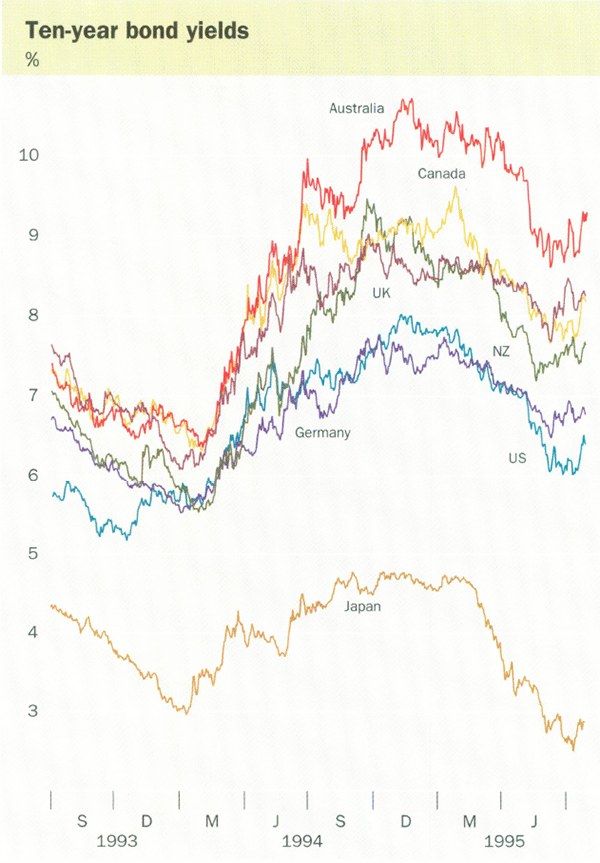
In the series of six US monetary policy tightenings in 1994, the rise of 0.75 of a percentage point in November was the largest, and an important catalyst for a change in sentiment in bond markets. Markets came to view this action as a decisive move to break inflationary expectations. This view was reinforced by a further tightening of 0.5 of a percentage point in February 1995, bringing the total increase in the Fed funds rate over the year to 3 percentage points. These preemptive tightenings by the US, and by some other English-speaking countries, came gradually to be viewed more favourably by the markets as the run of weaker economic news added to confidence that growth rates were returning to more sustainable paths. Earlier concerns about rising inflationary pressures, and therefore further rises in short-term rates in the US, began to appear overdone, especially given the modest rises in wages and consumer prices being recorded.
Movements in bond yields
(Percentage points)
|
Feb. 1994 to Nov. 1994 |
Nov. 1994 to June 1995 |
Net Movement |
Level at 30 June 1995 (per cent) |
|
|---|---|---|---|---|
| United States | 2.3 | −1.8 | 0.4 | 6.2 |
| Japan | 1.3 | −2.1 | −0.8 | 2.7 |
| Germany | 1.9 | −0.7 | 1.2 | 6.9 |
| Australia | 4.2 | −1.5 | 2.7 | 9.2 |
| Belgium | 1.9 | −0.9 | 1.0 | 7.6 |
| Canada | 2.7 | −1.3 | 1.4 | 7.9 |
| France | 2.5 | −0.7 | 1.8 | 7.6 |
| Italy | 3.6 | 0.5 | 4.1 | 12.6 |
| Netherlands | 2.0 | −0.7 | 1.3 | 7.0 |
| New Zealand | 3.7 | −1.6 | 2.0 | 7.6 |
| Sweden | 4.7 | −0.6 | 4.1 | 11.0 |
| Switzerland | 1.4 | −0.8 | 0.6 | 4.7 |
| United Kingdom | 2.4 | −0.3 | 2.1 | 8.4 |
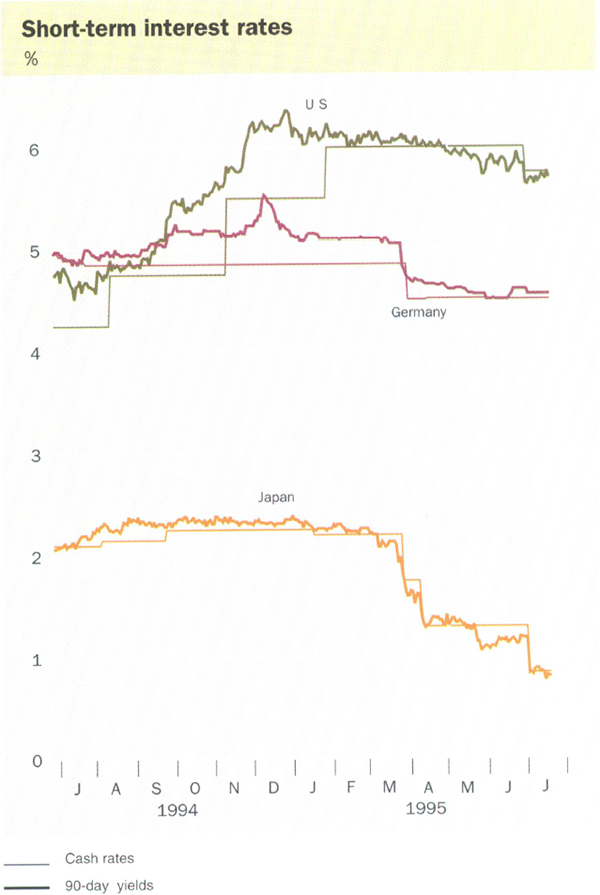
As weaker data on US output and demand accumulated through the first half of 1995, there was increasing speculation that the next move in the US would be an easing, adding impetus to the bullish mood in bond markets. By June 1995, 10-year US bond yields had fallen by 1.8 percentage points to 6.2 per cent, reversing most of the rise over the preceding 18 months. They fell further, to 6 per cent, when the Federal Reserve eased policy by 0.25 of a percentage point in early July, but came back to around 6.4 per cent later that month as signs of a further slowdown in the US economy became more equivocal.
Some rise in world bond yields was justified in the stronger economic environment of 1994, particularly given the historically low levels to which yields had fallen at the beginning of the year. Nonetheless, the sharp rises which occurred now appear to have overestimated the inflationary risks posed by the pick-up in economic activity, and to have underestimated the preparedness of central banks to take action to keep inflation under control. The early tightening of policy in a number of countries helped re-inforce this commitment to low inflation, thereby contributing to the fall in yields in the first half of 1995.
A number of factors specific to world bond markets operated to exacerbate movements in yields in 1994. The prolonged period of upward-sloping yield curves in a number of countries in the early 1990s provided investors with profitable opportunities to borrow short term to buy long-term securities. This applied equally to banks, institutional investors and members of the public through investments in mutual funds. Ready access to leverage, including through derivatives markets, enabled bigger positions to be taken, with a corresponding increase in risk.
These positions meant that bond markets, which had pushed yields to very low levels by early 1994, were not well placed to withstand shocks of the kind which came with the Federal Reserve's decision to tighten interest rates in February 1994. Losses from the initial sharp rise in bond yields were magnified by the high degree of leverage and the change in sentiment. The globalisation of markets, in particular the substantial international diversification that had been undertaken by US investors in recent years, meant that events in the US were transmitted quickly to other countries.
Apart from movements in bond yields, the other major development in international financial markets in 1994/95 was the re-alignment of currencies of the three main economies. The US dollar fell sharply in early 1995, reaching record lows against both the Japanese yen and the German mark in April 1995. As in bond markets, the common thread in the US dollar's fall against both currencies was the slowing of the US economy and the change in expectations regarding US interest rate movements.
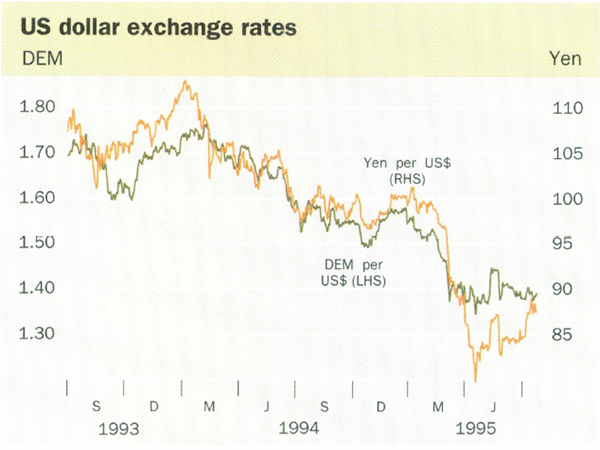
Other factors specific to the dollar's bilateral exchange rates with the German mark and Japanese yen were also involved. One such factor was the crisis in Mexico, which triggered a “flight to quality”, with the German mark the main beneficiary. The US dollar was sold heavily for a time on the back of concerns about the ability of US authorities to defend the dollar, given their heavy commitment of reserves to supporting Mexico. The Mexican situation also had wider, albeit passing, effects on the exchange rates of other emerging markets, including those in Asia.
The “safe-haven” attractions of the German mark gained weight as the exchange rates of a number of countries in Europe showed signs of strain. Countries which had abandoned their links with the German mark in 1992 began a second round of adjustment, as rising inflation – in part from the initial fall in exchange rates – renewed downward pressures on their currencies.
The Japanese yen's strength against the dollar was underpinned by Japan's continuing large trade surplus, on which were superimposed various flash points in trade negotiations between the United States and Japan. As the dollar continued to subside, many Japanese investors moved to repatriate overseas assets to avoid further large foreign exchange losses. This process aggravated the US dollar's weakness. Actions by some central banks to substitute yen assets for US dollar assets in their official reserves – often to hedge substantial yen liabilities – worked in the same direction.
The fall in the US dollar, particularly against the yen, did little to assist cyclical adjustments in the major economies. In Japan, it added impetus to the deflationary tendencies already evident in that economy, delaying the onset of a convincing recovery. The strong yen also had adverse implications for profits of Japanese exporters and share prices. The weakening in the share market, in turn, reduced the so-called hidden reserves of Japanese banks, exacerbating the pressures on them. In response to these developments, cash rates in Japan were cut by 0.5 of a percentage point in March, April and July 1995, reducing them to the very low level of about 0.8 per cent. For a time, the weaker dollar also added to concerns about inflation in the US, although the actual effects appear to have been slight, in part because of the modest extent of the US dollar's fall in trade-weighted terms (reflecting the sharp depreciation of the Mexican peso and the weakness of the Canadian dollar, both of which figure prominently in the trade-weighted index of the US dollar).

While the negative impact of the stronger exchange rate on economic activity in Germany was less severe than in Japan, it appears to have been one factor in encouraging the Bundesbank to cut official interest rates by 0.35 of a percentage point (to 4.5 per cent) in late March 1995. In both Germany and Japan, the actions taken to ease monetary policy were contrary to many expectations which were held as late as December 1994, when perceptions of possible increases in rates in response to forecast robust economic recoveries held greater sway.
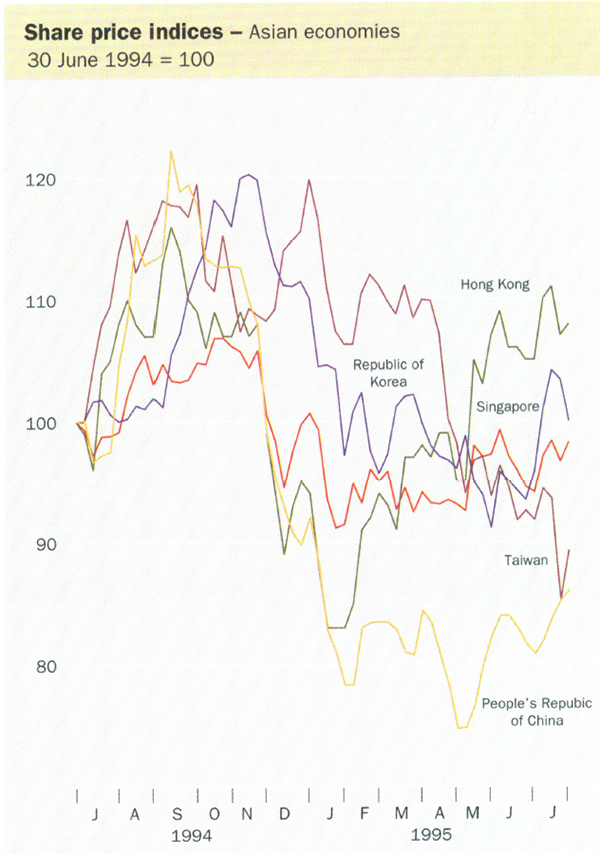
Equity markets in most countries fared better than in Japan, especially in the first half of 1995. In US and European markets, share prices fluctuated around a flat trend in the second half of 1994 as equities struggled in the face of deteriorating bond markets. In the first half of 1995, however, share prices on Wall Street moved progressively to new records as bond yields fell, companies posted high profits and prospects for cuts in official interest rates improved (and ultimately materialised). Over the year, share prices in the US rose by 26 per cent, in contrast to the fall of 30 per cent in Japan. In Germany and the UK, they were up by 3 per cent and 14 per cent, respectively, over the year. Further rises occurred in all these countries, and particularly in Japan, following the easings of monetary policy by the Fed and the Bank of Japan in early July 1995.
The emerging markets of Asia and Latin America generally were subdued during the year. One reason for this was the Mexican episode, which caused many institutional investors to pull back from all emerging markets. The switch by US mutual funds from international equities to domestic equities was particularly noticeable.
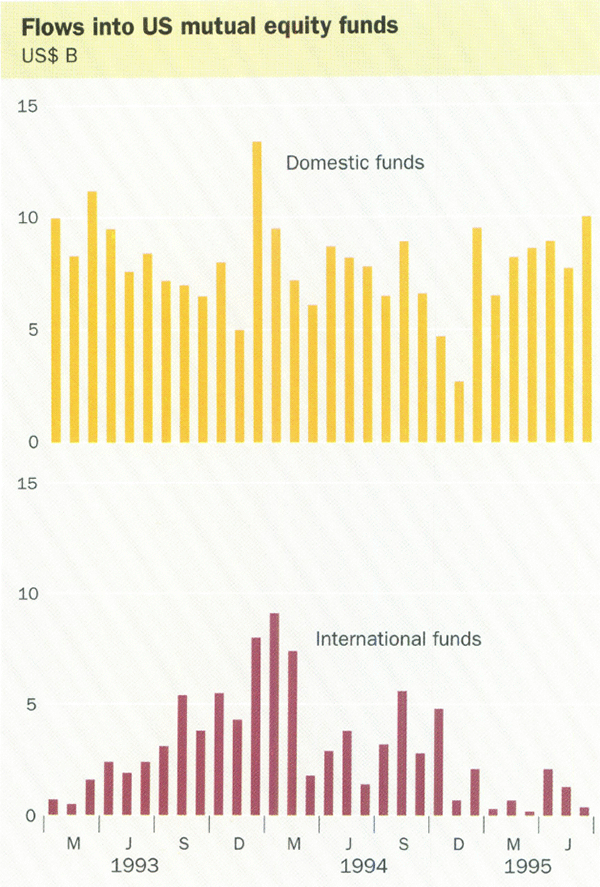
Developments in Australia
International developments, especially those in US markets, were an important influence on Australian financial markets during 1994/95. The change in perceptions about prospects for the US economy between the first and second halves of the year was mirrored by a similar change in perceptions about Australia. This resulted in an abrupt change in trends in both security yields and the exchange rate of the Australian dollar; the first half of the year was characterised by rising security yields and a stronger exchange rate, while the second half saw falls in both.
Australian interest rates were under upward pressure through most of 1994. Initially, that trend reflected the start of monetary tightening by the Federal Reserve in February 1994 and was evident mainly in bond yields. By mid 1994, signs of accelerating growth in Australia were emerging, adding further impetus to the rise in market interest rates.
Short-term yields increased substantially in the June quarter of 1994 and started the new financial year well above the cash rate, in anticipation of an early tightening of monetary policy. A tightening was announced on 17 August, with a rise in cash rates of 0.75 of a percentage point, to 5.5 per cent. After this move, and after each of the two subsequent tightenings of 1 percentage point in October and December, short-term interest rates rose quickly in expectation of further tightenings. Following the December tightening, the yield on 90-day bills reached 8.6 per cent, about 1 percentage point above the cash rate at that time. Yields on 180-day bills rose even more, to 9.4 per cent.
Bond yields also rose sharply during this period. In part, this reflected the worldwide rise in yields in response to moves in the US, although the rise in yields in Australia was larger than in most other countries. From a low of 6.4 per cent in early 1994, yields on 10-year bonds rose to about 9.75 per cent by mid 1994 and to a peak of 10.75 per cent late that year. The differential between Australian and US 10-year bond yields, which had fallen to a low of 70 basis points in early 1994, averaged 250 basis points during the second half of 1994. This increase in premium appeared to reflect a view in the markets that Australia's relatively poor record on inflation during the 1970s and 1980s was about to be resumed in the mid 1990s. Market concerns about inflation were not helped by the surge in the domestic economy, which saw growth rise to unsustainable rates during this period.
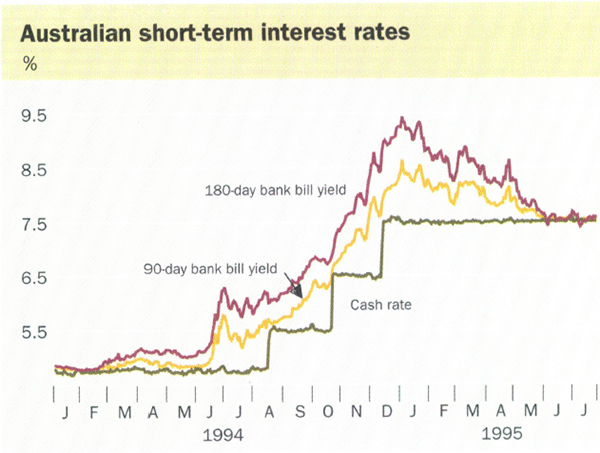
In this environment, the policy tightenings which commenced in August 1994 were important in giving investors confidence that inflation would be contained, and the rise in bond yields was interrupted on each occasion that monetary policy was tightened. By end 1994, however, the yield curve in Australia had a noticeably more positive slope than those in other economies at similar stages of the economic cycle, suggesting that investors remained concerned about inflationary pressures in Australia.
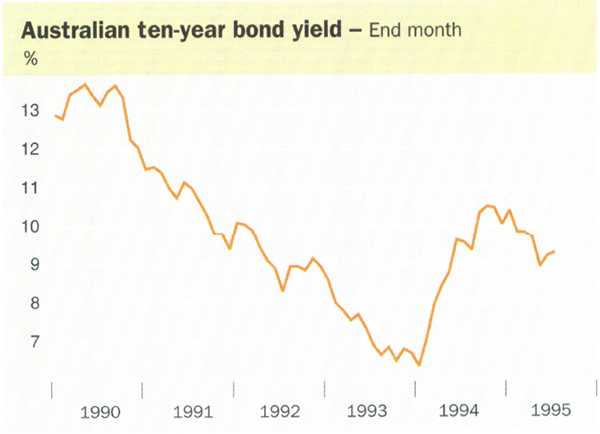
Signs of slowing in the Australian economy in early 1995, superimposed on a more pronounced slowing in the US, served to ease some of those concerns. As additional economic data became available, the further increases in official interest rates that markets had factored in began to look less likely. Reflecting this, yields on short-term securities moved from a substantial premium above the cash rate at the end of 1994, to close to level with it by June 1995. In other words, expectations for further tightenings had dissipated by the end of the financial year.
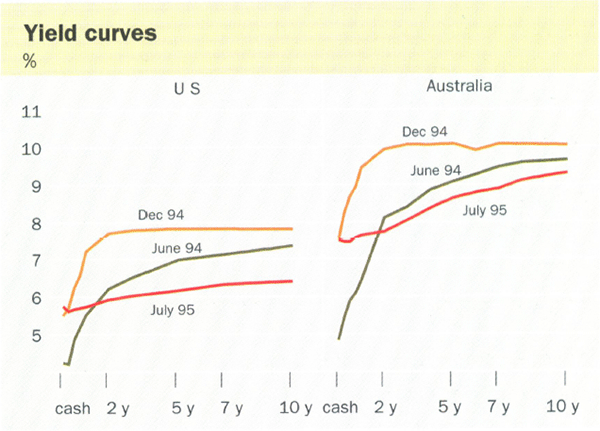
Short-term security yields in Australia have risen by around 2¾ percentage points since early June 1994. This is the same as the overall rise in the cash rate, although the rise in the latter was concentrated in a relatively shorter period in the second half of 1994. The rise in Australian short-term rates since early 1994 has been similar to the rise in US rates, but less than those in Canada and New Zealand.
When bond yields in the US and most other countries began to turn down in late 1994, the Australian bond market lagged behind. Concerns about the current account deficit and, associated with this, the exchange rate and possible policy responses, contributed to hesitancy in the local market. Bond yields in other countries had been falling for several months before signs of a decisive rally became evident in Australia in the June quarter. That rally was partly in response to further falls in overseas bond markets, but it also reflected a better-than-expected outcome for inflation in the March quarter and the tightening in budgetary policy announced in May. The latter helped to ease pressures in the bond market, given its implications both for aggregate spending in the economy and a marked reduction in the Government's own demands for funds. From a program of about $20 billion in 1994/95, Treasury bond issues are estimated to fall to between $3 billion and $4 billion in the current year; this is less than the value of maturing bonds, and will reduce the value of bonds outstanding.
Yields on 10-year bonds in Australia showed a net fall over 1994/95 of about 0.5 of a percentage point, to 9.2 per cent. They fell briefly to 8.8 per cent in early July when the US Federal Reserve eased monetary policy before retracing to 9.3 per cent later that month as US bond yields rose and inflation in Australia moved a little higher. This still left them about 2.9 percentage points above their low point in early 1994, a relatively large margin by international standards.
Movements in bond yields had an important bearing on the behaviour of the share market. In the first half of the year, share prices fell, despite the good profit results posted by most corporations, with the main factor being rising bond yields. The share market recovered in the second half of the year, as bond yields fell, but it lagged behind share markets in many other countries. The relatively high level of Australian bond yields contributed to this, as did softer commodity prices and general concerns about the large current account deficit. Overseas demand for Australian shares was weak. The All Ordinaries Index was 2017 at 30 June 1995, only marginally above its level at the start of the year. It subsequently rose by about 5 per cent during July, reflecting US and other interest rate reductions, and improved sentiment regarding world economic activity.
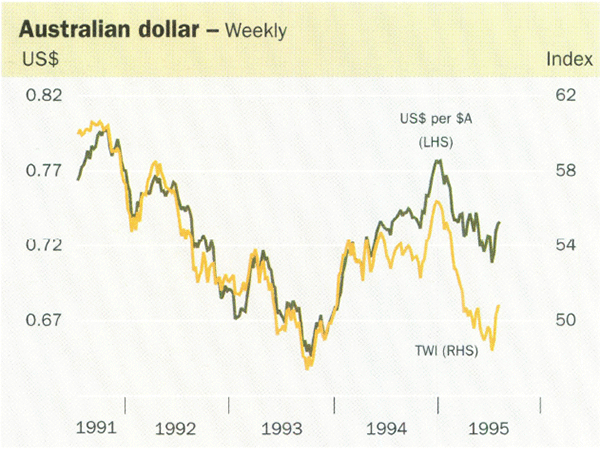
Movements in the exchange rate also varied between the two halves of the year. In trade-weighted terms, the Australian dollar rose from 53 in June 1994 to 56.5 at the end of December. This reflected the strengthening in the Australian and US economies, which benefited the Australian dollar through several channels. Higher commodity prices served to underpin demand for Australian dollars by international investors seeking to share in the gains expected to flow to the Australian economy. Tighter monetary policy, and expectations that interest rates would continue to rise, also boosted demand for the Australian currency. Against the US dollar, the exchange rate rose from US72.9 cents in June 1994 to US77.7 cents in December.
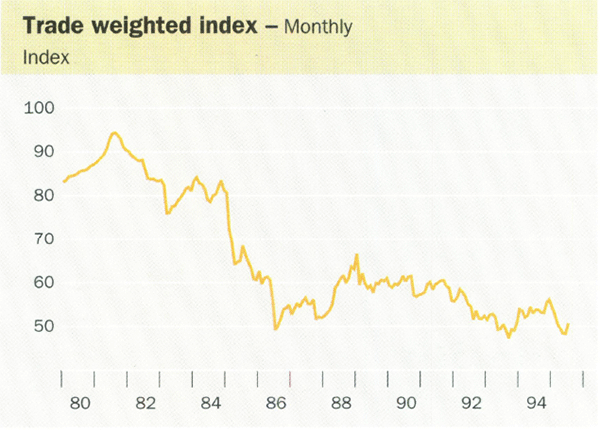
The moderate rise in the exchange rate during this period was seen as being broadly appropriate in the light of economic developments at the time. It marked a continuation of the recovery from the low point of 47.1 in the trade-weighted index reached in September 1993, and it was helpful as one check on inflationary pressures.
This uptrend turned around sharply in the early months of 1995 as signs of slowing activity (in Australia and overseas) began to emerge and commodity prices softened. Growing expectations that further interest rate rises in Australia were becoming more distant also weakened support for the Australian dollar. Of most importance, however, was the change in sentiment occasioned by the revised forecasts for the current account deficit which the Government released at the end of January 1995 (when the earlier estimate of $18 billion was revised to $26 billion, and subsequently to $27 billion in the May budget). This deterioration in outlook, confirmed by growing monthly figures, caused a good deal of uncertainty among foreign investors.
The tightening in fiscal policy announced in the May budget, while it was received positively in the domestic capital market, was overshadowed in the foreign exchange market by continuing concerns about the external deficit. Economic forecasts in the budget showing another large current account deficit in 1995/96 added to the bearish sentiment. Over the second half of the financial year, the Australian dollar fell steadily; in trade-weighted terms it declined by 14 per cent, while against the weakening US dollar it fell by 9 per cent.
The exchange rate recovered to around 51 in trade-weighted terms at the end of July 1995, following the reduction in US interest rates and more positive signs about US economic activity. Both factors prompted brighter expectations about commodity prices and sparked renewed interest in Australian dollar investments. The easing in US and other interest rates also served to widen the extent to which interest rate differentials favoured Australia. By end July 1995, the exchange rate against the US dollar was a little higher than at the start of 1994/95, but still 4 per cent lower in trade-weighted terms.
The weakness in the Australian dollar in the second half of 1994/95 was associated partly with the sharp decline in the US dollar, although this was a secondary influence. Market perceptions of “dollar bloc” countries can occasionally help to explain day-to-day movements in the exchange rate for the Australian dollar, but any such influence tends to be small and transient. Other “dollar bloc” currencies such as the Canadian and New Zealand dollars strengthened, rather than weakened, during the same period.
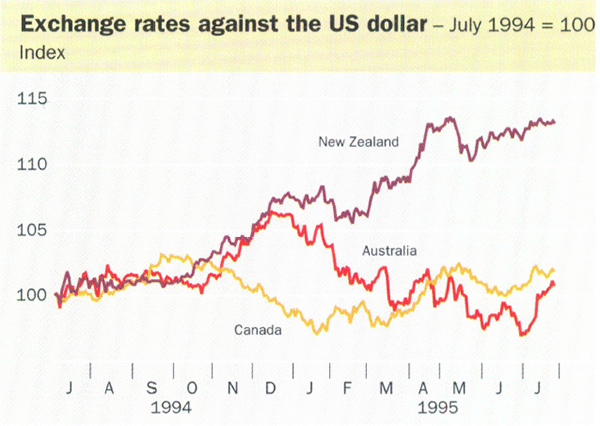
Notwithstanding the fall in the second half of the year, the Bank did not see a need to intervene in the foreign exchange market. The adjustment had occurred in orderly conditions, with few signs of speculative activity of the kind which had characterised the foreign exchange market at times during 1992 and 1993. There was, moreover, no loss of confidence in Australian financial markets generally – foreign investors, for example, made significant purchases of Australian bonds. As noted, the weakness reflected mainly concerns about prospects for the current account. That problem had to be tackled primarily by budgetary policy aimed at increasing national savings over an extended period of time. While the lower exchange rate had the potential to add to inflationary pressures, it was not seen as a trigger for a further tightening, particularly amid signs of a slowing in the domestic economy.
The Bank's market operations
The Bank did not undertake any foreign exchange intervention in 1994/95. It did, however, run off some of the outstanding swap positions which had been built up by its intervention in previous years. Partly for reasons of portfolio management, sales of foreign exchange in 1992 and 1993 had been funded through the swap market, rather than by liquidating the Bank's holdings of foreign securities. The Bank's net swaps outstanding, under which it is committed to deliver foreign exchange, declined from $10.8 billion at the start of the year to $8.7 billion at end June 1995.
The Australian dollars received from these deliveries of foreign exchange were used to increase the Bank's holdings of Commonwealth Government securities (CGS), at yields which were attractive relative to those on offer from the Bank's foreign assets. Over the year, holdings of foreign exchange fell by $1.9 billion (net of valuation effects) to $15.1 billion, while holdings of CGS rose by $2.4 billion to $15.7 billion.
Details of the Bank's transactions in CGS are provided in the table below. These operations were undertaken for the purposes of liquidity and monetary management and, as the table indicates, most transactions were in the form of repurchase agreements. Repurchase agreements involve the purchase or sale of a security, with an undertaking to reverse the transaction at an agreed date in the future, and at an agreed price. They are used extensively by the Bank in its market operations because their maturity can be tailored to meet the specific liquidity needs of the market; the term to maturity for these agreements typically averages around two weeks.
Domestic market operations
($ billion face value)
| 1993/94 | 1994/95 | ||
|---|---|---|---|
| Repurchase agreements: | purchases | 73.8 | 100.5 |
| sales | 76.0 | 97.8 | |
| Outright transactions: | |||
| – Short CGS | purchases | 8.7 | 8.5 |
| sales | 4.8 | 1.2 | |
| – Longer-term bonds | purchases | 1.0 | 2.3 |
| sales | 1.8 | 0.7 | |
The Bank also conducts tenders of securities on behalf of the Commonwealth Government. The size, composition and timing of these tenders are determined largely by the Treasury, having regard to its financing needs. During the year, 24 tenders for Treasury bonds were held, through which $19.3 billion of stock was issued to the public. In addition, the Bank took up $0.7 billion of stock at these tenders for its own portfolio needs. Tenders for Treasury notes were held each week. Over the year, Treasury notes on issue fell by $2.0 billion, in part a consequence of the Government broadening its debt issues to include Treasury adjustable rate bonds (TABs). Three issues of TABs totalling $3.7 billion were made during 1994/95; they were conducted through a syndicate of underwriters but a future move to tender arrangements is envisaged. The TABs were issued with a maturity of three years, and carried a floating-rate coupon which is reset quarterly by reference to movements in the Australian Bank Bill Swap Reference Rate.
Primary issue arrangements for Treasury indexed bonds were changed during the year. In July 1994, the Treasury announced that future issues of these bonds would be by competitive tender, rather than through the dealer panel process which had been used previously. Six tenders were held under these arrangements during 1994/95, for total issues of $545 million.
In respect of its own domestic market operations, the Bank announced in May that these operations would need to change in the year ahead as a consequence of the proposed move of interbank payments to a real-time gross settlement (RTGS) system. At present, the Bank conducts its operations in Treasury notes and repurchase agreements with a group of institutions known as authorised dealers in the short-term money market. With the move to RTGS, there will no longer be any special role for the authorised dealers.